Although few expected it when COVID-19 first entered the scene, the pandemic has ushered in the future of remote working. Today, understanding hybrid and remote work trends enables both businesses and their employees to remain competitive in this new era. How should employers and IT personnel support remote and hybrid workers? And how can entrepreneurs and independent workers ensure they have the correct setup for home Internet security?
In this post, we cover some remote work statistics, as well as work from home expectations, and how to support a productive and secure workplace wherever you and your staff members plant your desks. Read on to gain valuable insights into the latest remote working facts and statistics.
Remote Work Statistics
In the early months of the pandemic, the expectation was that things would eventually go back to “normal.” But more than two years later, the remote worker is now a fixture of modern life. For many businesses and employees, there is no going back to the old “normal.”
The
remote work facts tell a story of mostly successful adaptation to a new set of conditions. Today, organizations are considering what they learned from the lockdowns and are reassessing their strategies to prepare for the road ahead. The
2021 Upwork Future Workforce Report predicts that 40.7 million Americans will work in fully remote environments in the next five years. There were significant concerns about maintaining productivity at the outset, but it seems that these fears were unfounded:
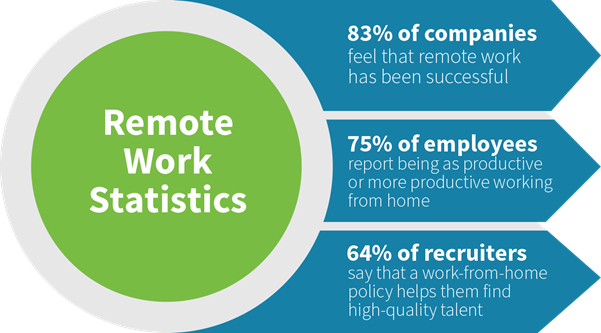
Meanwhile, another report found that
54% of employees feel overworked, which will remain a serious concern for employers going forward. The pandemic highlighted the importance of well-being, with more people seeking a better work-life balance than ever before. In consideration of the widespread labor shortage and in the interest of sustainability and employee retention,
employers are making accommodations.
These changes are evident in flexible workspaces, flexible hours, and
hybrid work models to support and retain a flexible remote workforce.
What Is Remote Work?
What does it mean to work remotely? Years ago, “working from home” was simply not possible for most people. The introduction of the laptop computer and the Internet, however, changed all that. The types of jobs that can be performed remotely are now vast, thanks to today’s technology.

Nearly any traditional office job can be performed at least in part from a remote location. So, what types of jobs are remote? These include sales, marketing, software development, graphic design, human resources, copywriting, accounting, legal work, and many other roles.
However, one of the challenges, as we will discuss, is to
set up the home office network to be as secure and cyberattack proof as the corporate network to ensure that online activities in the home environment have no chance of resulting in a data breach that can impact corporate assets.
5 Work from Home Trends to Track
Even
before the pandemic, the option to occasionally work from home was a highly desirable perk, though it was far less common than today. Yet, companies that allowed employees to work remotely often saw better retention, happier employees, and greater loyalty to the company in general. Fast forward, and now with the much broader adoption of remote work since the onset of COVID-19 restrictions in the spring of 2020, several trends have emerged that underscore what employers need to focus on to make remote work sustainable in the long run.
The need for heightened network security, the adaptation of HR practices, a renewed focus on internal culture and communication are just a handful of the highlights of today’s work from home trends.

1. Cybersecurity Has Become Essential
Cybercrime exploded during the pandemic as malicious actors took advantage of work from home trends. The increase in people working from home exacerbated vulnerabilities that cybercriminals quickly exploited to attack the networks and systems not only of corporations, but of hospitals, universities and other organizations of all kinds.
Organizations with inadequate cybersecurity found themselves at risk across several fronts:
- Unauthorized access to confidential data — both data at rest and data in transit
- Denial of service attacks and the potential of ransom payments to cyber-criminals
- Loss of business continuity while the organization recovers from a data breach
- Regulatory fines for violation of data privacy rules, especially in regard to medical records
- Reputational damage, impacting brand image and trust with customers and the general public
In addition to business disruptions, the financial costs of cyberattacks are high and getting higher. Here are some sobering statistics on the current cost* of a typical data security breach:
- Average total cost of a single data breach rose to $4.24 million in 2021, the highest in 17 years
- Data breaches where remote work was a factor cost an average of $1.07 million more than data breaches where remote work was not a factor
- Compromised credentials were the most common point of attack, responsible for 20% of all data breaches
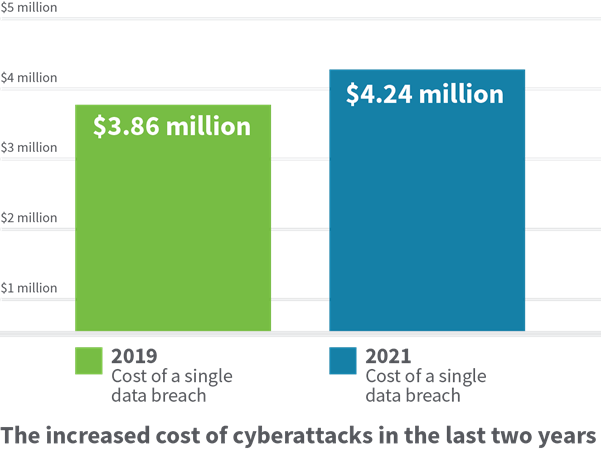 *Source: 2021 Cost of a Data Breach Report, Ponemon Institute LLC, 2021
*Source: 2021 Cost of a Data Breach Report, Ponemon Institute LLC, 2021
Mitigating Cyber Security Risk
To mitigate the risk, employers are putting a greater
focus on cybersecurity with multiple strategies aimed at threat detection and preventing unauthorized access. Simple username/password combinations are not sufficiently secure, so employers are deploying single sign-on and multi-factor authentication (MFA) logins. Both practices protect company data with advanced encryption, providing an extra layer of security.
When members of a household share a home network, the potential for a catastrophic breach increases dramatically. For that reason, employers are beginning to provide
enterprise-grade cellular routers for remote employees to have at their homes. This strategy serves to isolate work equipment from the home network, providing corporate-level security to prevent the possibility of family streaming, email and download activity from impacting the integrity of corporate data.
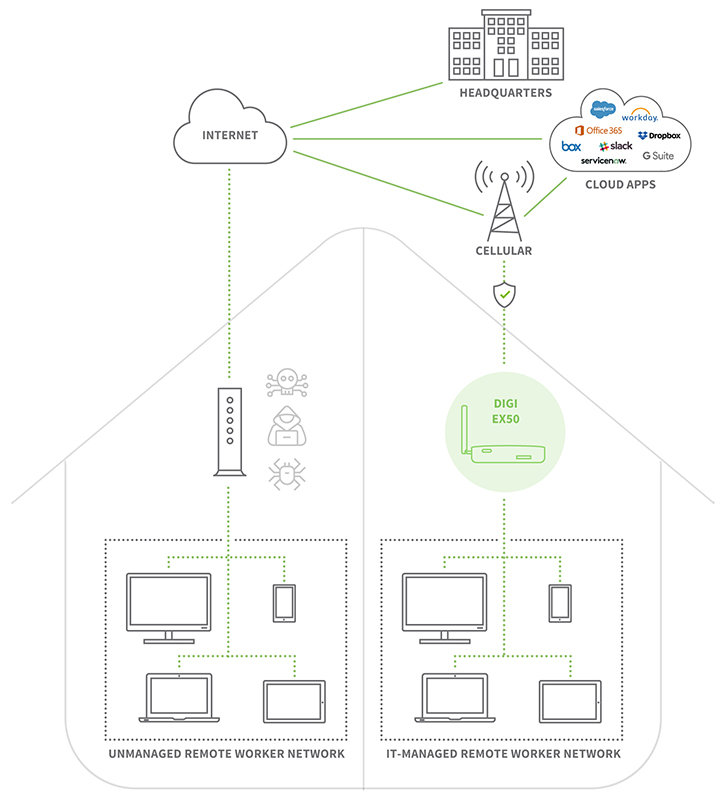
2. Employing a Managed Home Office Model
Home offices expand the boundaries of the corporate network. It is therefore important for the IT organization to manage these network extensions effectively and efficiently — remotely, and in many cases also from a home office.
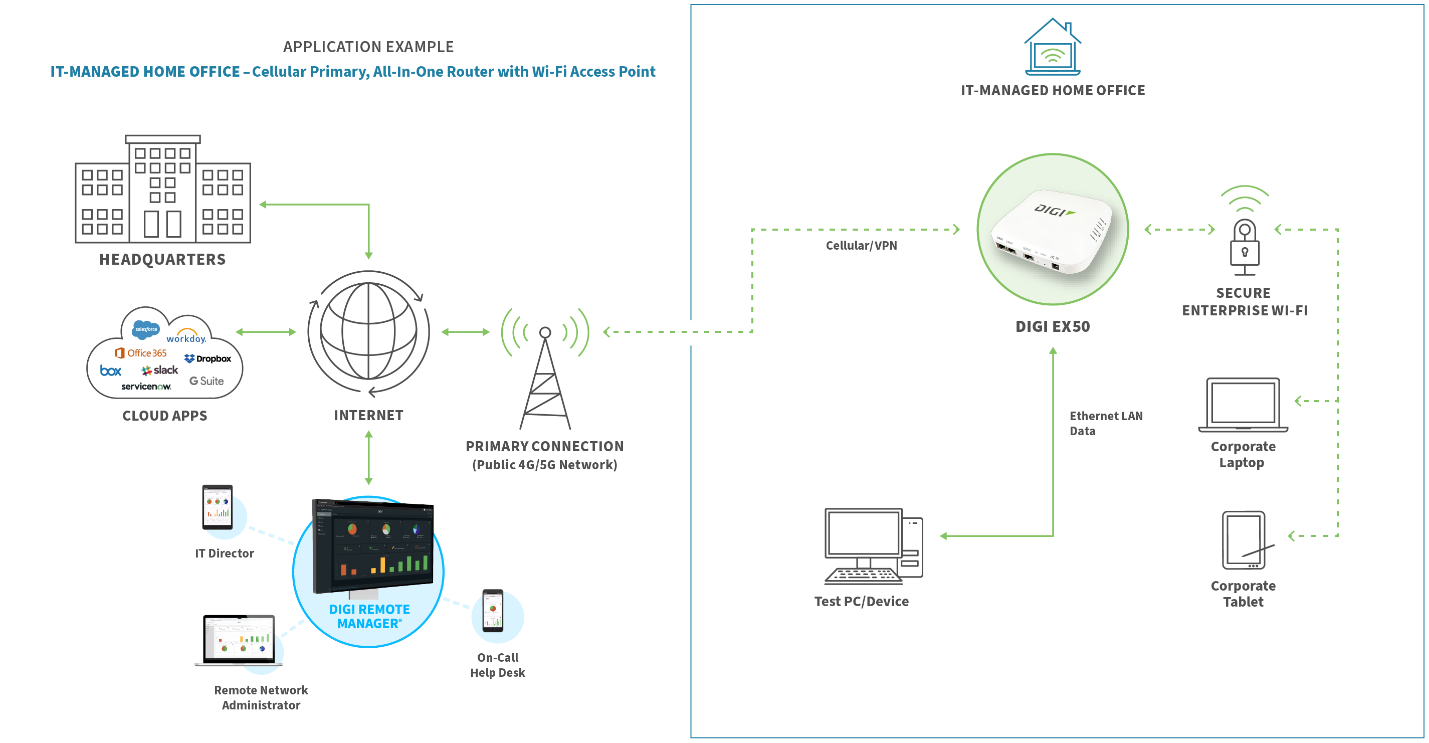
This strategy ensures that management of remote systems is under IT control, and the connection to the corporate network is fully secured.
The Digi Connection for Home Office Workers
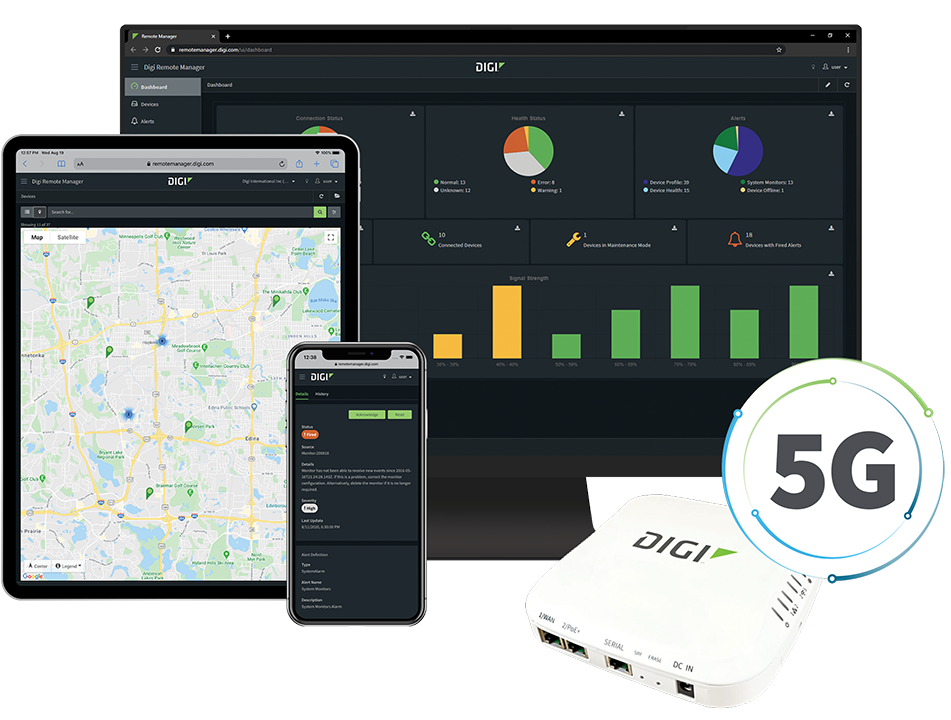
The
Digi EX50 5G cellular router is an ideal choice for the
home office environment. Digi EX50 is a premium, Gigabit-speed device, which corporate IT departments would likely want to roll out first to executive staff as well as staff with high bandwidth needs, for example solution developers, graphic designers, and others.
5G connectivity helps with lower latency for improved video/audio calls and when many small files need to transferred. It’s important to note, however, that because 5G service is limited in some areas, EX50 offers 5G/4G dual connectivity, so in those areas with limited 5G, it is an excellent solution to future proof the home office.
Digi EX50 was built from the ground up to deliver true Gigabit system performance:
- A 5G/4G dual-connectivity radio provides Gigabit cellular connectivity
- Dual-band Wi-Fi 6 radios provide Gigabit Wi-Fi with the latest WPA3 security
- And dual multi-Gigabit Ethernet ports route packets at Gigabit speeds
Digi Remote Manager® enables centralized management and configuration of home office networks and devices. IT organizations can easily secure the connection between the home office and the corporate network or cloud applications through VPNs, keep their fleet of devices up to date, do mass configuration changes, and automate security audits and remediate issues remotely, all through a single pane of glass.
It also has
Digi TrustFence® IoT security framework built-in, which protects the device at its core through device security, device identity, and data privacy capabilities.
For remote personnel and self-employed workers who may not need the high speed and low latency of EX50, the
Digi EX15 LTE cellular extender is an enterprise-grade device that is an affordable alternative, with the same integrated remote management and security. It is sufficient to provide 25/3 Mbps Internet or even 100/20 Mbps Internet. For needs beyond that, EX50 will be a better option.
3. Restructuring and Adapting HR Practices
Human resource (HR) policies and practices have had to undergo a number of changes to adapt to work-from-home trends and hybrid work models. As companies have gradually started calling employees back to the office, they’re finding that many workers are content with working from home and don’t see a need to return as long as the work is getting done.
This attitude is especially common among younger workers without a long history of working in a traditional office environment. In some cases, workers will come into the office on a given day and find that
members of their own team are not there. In those situations, workers find little point in even making the effort. Hybrid work arrangements, like remote work in general, are very popular with both employers and employees:
*Source: Chris Hughes, Gen Z, millennials and Gen X all basically agree on work from home, St. Paul Pioneer Press, June 12, 2022
The issue of “location-based” pay adjustments for remote workers is another issue that is problematic for HR departments responsible for employees working in cities with a high cost of living, such as New York or San Francisco. In the past, employees in those cities would often get a salary premium to compensate for higher rent, commuting costs and other expenses.
Because of the pandemic and for lifestyle reasons, many of these people have now moved to less expensive regions. But, not surprisingly, they are unwilling to accept a reduction in pay. To deal with the reality that job location is increasingly a matter of personal choice rather than employer mandate, many companies are simplifying location-based pay tiers or eliminating them altogether.
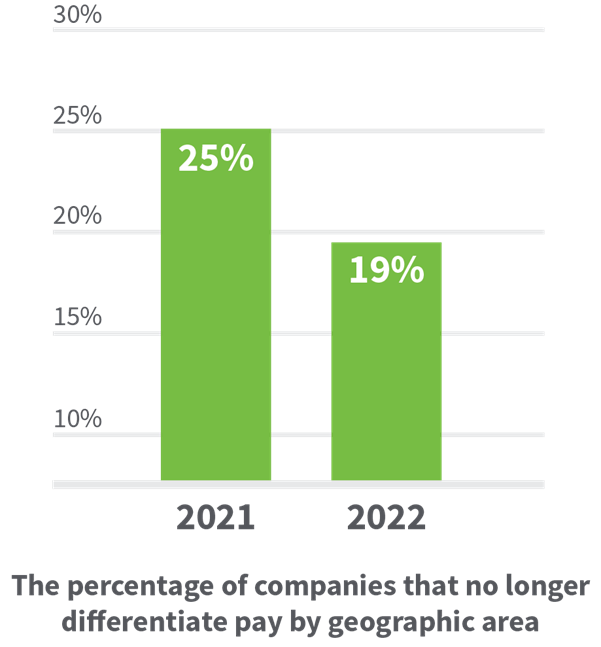 Source: Matthew Boyle et al, Rethinking Fair Pay, Bloomberg Businessweek, May 23, 2022
Source: Matthew Boyle et al, Rethinking Fair Pay, Bloomberg Businessweek, May 23, 2022
4. Reshaping Company Culture and Communication
Why work remotely when many people are returning to the office? The work from home trend has forced many people to work on their own for the first time and many employees enjoy the freedom they have while working from home. On the other hand, they risk disengagement from the organization, distraction, and the isolation of not working alongside their teammates.
In addition, many have to manage their workload while juggling household and family duties, while some people living alone may experience isolation. Whereas we could once toss ideas back and forth across the desk or come up with ideas over a coffee break, we must now work a little harder to achieve the same results since we’re not working alongside our team.
These ongoing issues indicate the need for a shift in culture and communication. A strong company culture relies on meaningful connections. Some useful
strategies and insights for maintaining team connections have emerged over the last two years:
- Meet online regularly and make sure everyone has an opportunity to contribute
- Ensure that basic technical skills are maintained. Employees must understand how to access the systems they need and to properly navigate security policies
- Prioritize outreach and transparency where planning is concerned
It’s also important to make an extra effort to recognize achievements. Recognition is a huge motivator that sends a signal to remote employees that their work is noticed and appreciated. Recognition can range from simple acknowledgment, to small perks, tokens of appreciation, or career development opportunities.
The right technology can make a big difference in nurturing team relationships and ensuring that clear, high-quality, low-latency communications are as secure as they are reliable.
5. Less Office Space Is Required
Many companies realized during the pandemic that they could do surprisingly well without employees in the office. Moreover, with the need to maintain costly real estate reduced, the potential for savings was substantial. As a result, some companies downsized to the point of leaving entire buildings behind in favor of a much smaller footprint where they could support flexible office space for employees who had to be on premises occasionally.

Additionally, many employees no longer needed to live close to work and moved to better housing in more affordable areas. Since 2020, 4.9 million people in the U.S. (2.4 percent of Americans) have relocated because of the availability of remote work arrangements.*
A few companies may even
choose to go 100% remote, sell some of their buildings, and prioritize the digital work model. It’s a move with many benefits, not the least of which is improving the bottom line.
*Source: Matthew Boyle et al, Rethinking Fair Pay
, Bloomberg Businessweek, May 23, 2022
Is Working from Home the Future?

Many are asking these questions. Is remote work the future? Will working from home become the norm? Or is a hybrid work model that enables employee and employer flexibility the more likely course for the future?
Remote work has been a relief for many employees worldwide, and they often enjoy the quiet and the greater productivity that can result from uninterrupted work. This certainly would not have been the case if COVID-19 had happened 20 years ago. Without the technology and connectivity we enjoy today, none of what we’ve accomplished would have been possible — or even imaginable.
Consider these insights from a range of remote work news sources into why we see remote work on the rise:
Find the Best Remote Connectivity and Management Solutions for Your Business at Digi
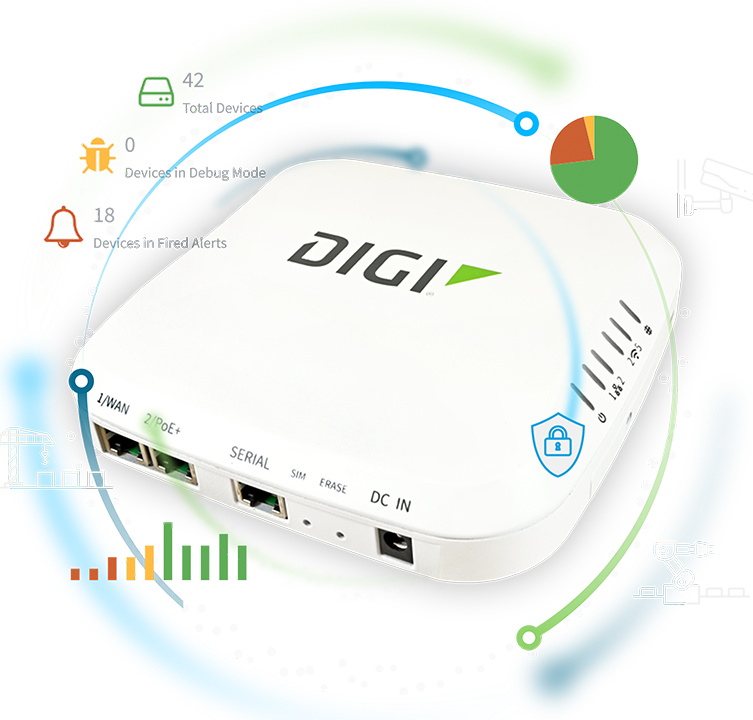
While it's not the right model for every enterprise or every worker, it appears that remote work and long-term hybrid work structures are the future of work, staffing and IT considerations.
Many companies have adapted and have seen only positive impact on worker productivity. Now, most are stronger than ever and ready to embrace a remote work future, supported by technology and the knowledge they can operate successfully.
And today, the most successful companies supporting remote workers will ensure that their employees have the right tools to do their jobs safely and securely.
Digi’s
remote connectivity solutions provide
secure, reliable tools for remote employees, supporting fast, efficient, high-quality connections and ensuring maximum productivity.
Next Steps